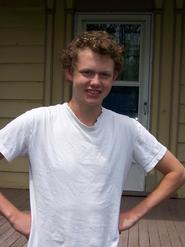
iPhones are slick and manageable, which is why the owner of one gets a certain satisfaction out of using it. He likes the sleek black frame and the way the icons slide effortlessly across the screen. He revels in the idea that a cornucopia of entertainment is available to him with the touch of a thumb. The way in which he interacts with this piece of technology is called the user interface. In other words, it is the ease with which a person is able to assess the state of system and how he can use it to his best advantage. This summer, Samuel Hincks '11 is working with Stephen Harper Kirner Professor of Computer Science Stuart Hirshfield to analyze how cognitive workload can help facilitate user interface.
Different structures in the brain contribute to whether or not a customer finds a product too bulky or challenging to use. The first step of Hincks' research involves studying what areas of the brain play a role in user interface and how computer scientists can assuage the effects of information or sensory overload. During the two weeks that Hincks spent on this first step, he found that the prefrontal cortex is imperative. He also discovered that short-term memory is capable of storing about seven digits at a time. This information helps technology designers settle on how much data a person had handle at a given moment.
The next step, which took Hincks about a week, required that he track brain activity to confirm what he read in books and articles. He used Functional Near-Infrared Spectroscopy (fNIRS), a neuro-imaging method for processing activity in the brain. Although it is similar to scans like Functional Magnetic Resonance Imaging (fMRI) and electroencephalography (EEG), it is more optimal for research purposes. A headband is wrapped around the participant's head and tracks the relationship between metabolic activity and oxygen level (oxygenated hemoglobin) in blood vessels.
The final step of his research will be to classify different brain states and evaluate possible algorithms for that classification. If Hincks finds that brain activation during use of certain machines or computers is associated with cognitive workload, then the user is being overworked. Other brain states will correspond to the device's attributes and thus show a direct approach to eliminating user dissatisfaction.
As a computer science major and psychology minor, Hincks appreciates that his summer project is able to fuse the two subjects. To him, the decision to apply for a summer research position in computer science was a no-brainer.
"It's such a good deal," he said. "You get paid. You learn more about professional research. You can work with great professors. Plus, you get to sit and write [computer] programs all day. It's awesome."
Different structures in the brain contribute to whether or not a customer finds a product too bulky or challenging to use. The first step of Hincks' research involves studying what areas of the brain play a role in user interface and how computer scientists can assuage the effects of information or sensory overload. During the two weeks that Hincks spent on this first step, he found that the prefrontal cortex is imperative. He also discovered that short-term memory is capable of storing about seven digits at a time. This information helps technology designers settle on how much data a person had handle at a given moment.
The next step, which took Hincks about a week, required that he track brain activity to confirm what he read in books and articles. He used Functional Near-Infrared Spectroscopy (fNIRS), a neuro-imaging method for processing activity in the brain. Although it is similar to scans like Functional Magnetic Resonance Imaging (fMRI) and electroencephalography (EEG), it is more optimal for research purposes. A headband is wrapped around the participant's head and tracks the relationship between metabolic activity and oxygen level (oxygenated hemoglobin) in blood vessels.
The final step of his research will be to classify different brain states and evaluate possible algorithms for that classification. If Hincks finds that brain activation during use of certain machines or computers is associated with cognitive workload, then the user is being overworked. Other brain states will correspond to the device's attributes and thus show a direct approach to eliminating user dissatisfaction.
As a computer science major and psychology minor, Hincks appreciates that his summer project is able to fuse the two subjects. To him, the decision to apply for a summer research position in computer science was a no-brainer.
"It's such a good deal," he said. "You get paid. You learn more about professional research. You can work with great professors. Plus, you get to sit and write [computer] programs all day. It's awesome."
